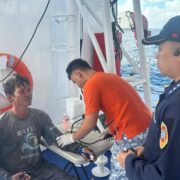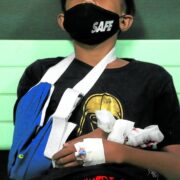Coordinate efforts vs leptospirosis

Filipinos wading or swimming in flood waters every time a typhoon hits the country has become a common sight and is used to illustrate people’s resilience to disasters. But behind these viral images lies a public health threat—contaminated water that causes leptospirosis.
The Department of Health (DOH) last Thursday reported 523 new cases of leptospirosis from Aug. 8 to 13, with 43 deaths, most of them from the National Capital Region (NCR). The DOH said the number of cases was in addition to the 255 recorded nationwide from July 25 to Aug. 7 after Supertyphoon “Carina” and the enhanced southwest monsoon dumped heavy rains and caused floods across NCR and nearby provinces.
About 81 percent of the cases or 423 were adults, and 19 percent or 100 were children; of the fatalities, 41 were adults and two were children. The surge in cases was beyond capacity that the National Kidney and Transplant Institute had to use its gym to accommodate more patients.
“This outbreak was predicted after many Filipinos carelessly waded and played in floodwaters! Again, all flood waters are dirty and high risk for getting infected by the Leptospira bacteria,” said Health Secretary Teodoro Herbosa in a Meta post on Aug. 7.
Health literacy
Leptospirosis is the most common zoonotic infection in the world and is easily transmitted from infected animals through their urine, either directly or through infected soil or water. What is even more dangerous and perhaps unknown to many is that the bacteria can survive in contaminated water or soil for weeks or months. If untreated, it can lead to kidney damage, meningitis, liver failure, breathing trouble, and even death. Symptoms such as fever, headache, chills, body or muscle aches, vomiting or nausea, and yellowed skin and eyes can manifest three weeks after exposure.
The health secretary emphasized the importance of health literacy, especially among children who need to be educated on the dangers of swimming in flood waters. Leptospirosis patients need critical care—as Herbosa himself said, it is labor intensive and requires high-level personnel, dialysis for the disease’s renal effects, and antibiotics. Of the cases reported by the DOH, eight patients were on mechanical ventilators and 243 were undergoing dialysis.
Rodent population
Our broken health system cannot afford a leptospirosis outbreak given the lack of facilities, personnel, and even funds although finance officials would have the public believe there is an excess worth billions of pesos. There are also other diseases that need the health sector’s attention and the public’s vigilance including mpox, which the World Health Organization recently declared as a public health emergency of international concern.
The leptospirosis outbreak, however, is not only a “behavior problem,” as Herbosa called it. The disease is the consequence of many problems: poor sanitation, improper garbage disposal, and lack of a comprehensive flood control plan.
“When solid waste management is poor, the rodent population numbers increase. When the rodent population numbers increase, leptospirosis cases will increase,” Herbosa said, adding that controlling the rodent population should be a “public health endeavor.”
Herbosa has urged local governments especially those in flood-prone areas to ban people, particularly children, from swimming in flood waters. At least one mayor from Metro Manila has responded with a plan to certify as urgent an ordinance imposing the ban and meting out penalties.
Root causes of the disease
This solution, however, ignores the reality that floods in some areas take time to subside so people are forced to wade in them not out of sheer carelessness but necessity—they need to check on their homes that they were forced to evacuate, or they need to go to school or work, among other legitimate reasons. The DOH data also show that majority of leptospirosis patients were adults, not children. Who would want to get sick in this country, especially if you are poor? This solution also deflects from government responsibility in terms of sanitation, waste disposal, and infrastructure.
This is why the health secretary’s call for an inter-agency coordinated effort against the infectious disease should be followed through, and swiftly. Aside from educating the public on the dangers of dirty flood water, the health department should also ensure that doxycycline, used in treating leptospirosis, is available at health centers and in the market.
And while the public should be more mindful and vigilant in protecting their health, the government should do its part in conducting sanitation drives, strictly implementing solid waste management and disposal laws, and building the proper infrastructure to reduce flooding during heavy rains and typhoons.
Herbosa is right, the government cannot “[keep] doing the same thing and warning and not do something significant.” It has to address the root causes of the disease: trash, rodents, and clogged drainages.

















